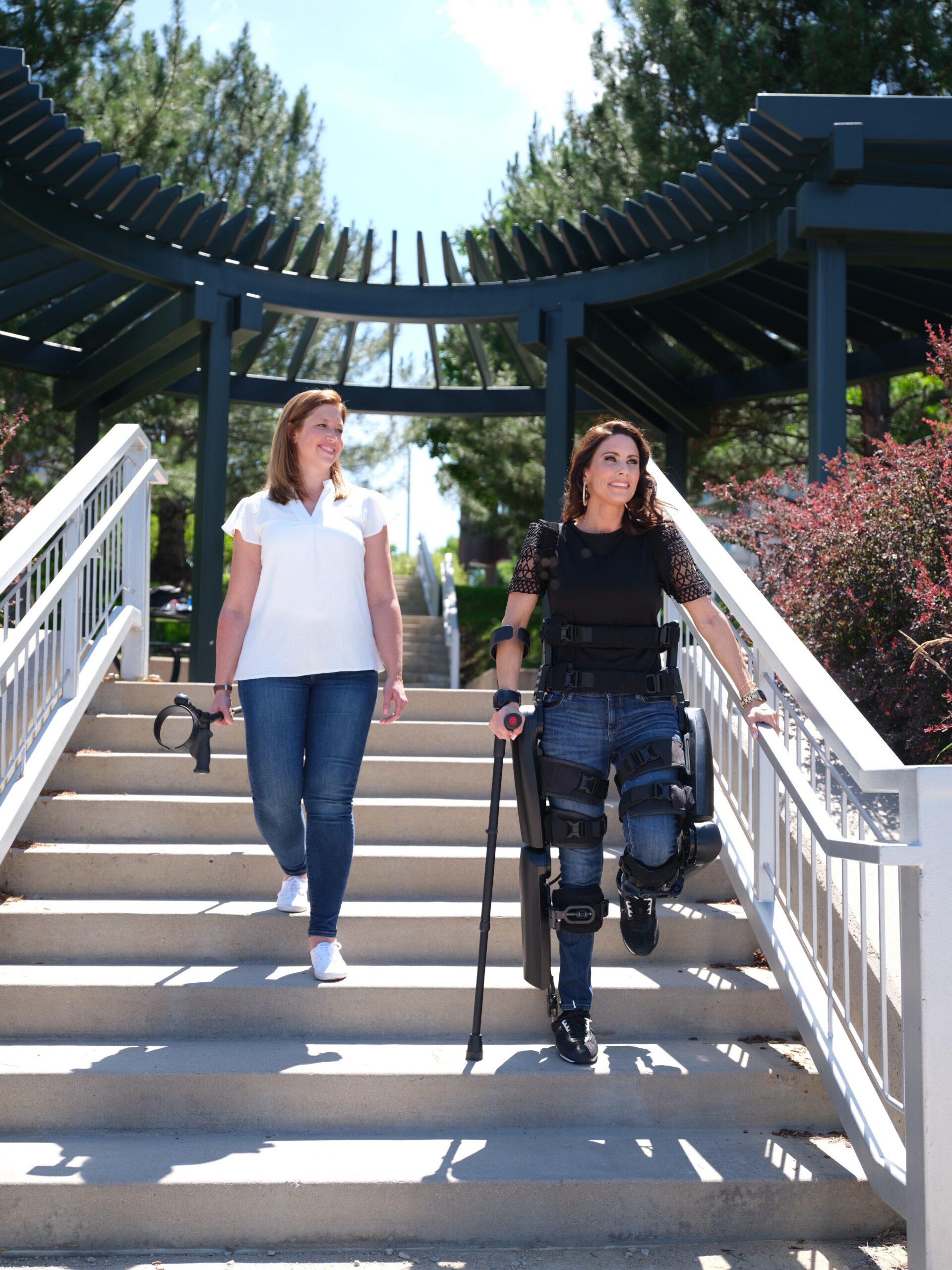Personal Exoskeletons
Exoskeletons for individuals living with spinal cord injury can be divided into two categories: those intended for use in rehabilitative settings and those intended to be utilized in the home and community. This section will focus on those intended for home and community use, which are collectively referred to as personal exoskeletons.

The ReWalk Personal Exoskeleton by Lifeward was the first system to be approved by the FDA for home and community use in 2014, and the Ekso Indego Personal by Ekso Bionics followed in 2016. The systems work by providing user-initiated mobility through the integration of a wearable, motorized brace support, a computer-based control system, and motion sensors, and while there are some differences between the two products, there are also many similarities. Most importantly, while not intended to be a replacement to a wheelchair for mobility purposes, both are intended to help individuals achieve the benefits of walking in their everyday life. The primary differences between the two commercially available devices are their FDA indications for use; the Indego is on label for individuals with spinal cord injury at levels between T3-L5 and ReWalk T7-L5, and the Indego is not intended for sports or stair climbing, while the ReWalk received FDA clearance for stairs and curb functionality in 2023.
Clinical evidence suggests that regular access to exoskeleton-assisted walking is associated with a number of health benefits that can help to address some of the secondary medical complications related to spinal cord injury. Some of these health benefits include: reduced pain and spasticity, as well as improved bowel function, mood and quality of life.1,2,3,4,5 There is also anecdotal evidence that robotic walking helps bone density and bladder function, in addition to offering users an option for interacting eye-to-eye with others, and access to standing and walking-based activities in real-world environments of daily life.
Aside from FDA approval and medical eligibility, insurance coverage is the final piece that will allow individuals access to this life-changing technology. The Veterans Administration was the first group to establish a coverage policy and has been helping eligible veterans experience standing and walking in their homes and communities since 2015.6 As of January 1, 2024, Medicare has begun covering personal exoskeletons for medically eligible individuals under the brace category.7 Insurance coverage for personal exoskeletons continues to evolve, so individuals interested in pursuing a personal exoskeleton are encouraged to speak with their clinicians, their insurance company, or the device manufacturer for the most up-to-date information.
- Shackleton C, Evans R, Shamley D, West S, Albertus Y. Effectiveness of over-ground robotic locomotor training in improving walking performance, cardiovascular demands, secondary complications and user-satisfaction in individuals with spinal cord injuries: A systematic review. J Rehabil Med. 2019 Oct 29;51(10):723-733. doi: 10.2340/16501977-2601. PMID: 31511902.
- van Nes IJW, van Dijsseldonk RB, van Herpen FHM, Rijken H, Geurts ACH, Keijsers NLW. Improvement of quality of life after 2-month exoskeleton training in patients with chronic spinal cord injury. J Spinal Cord Med. 2024 May;47(3):354-360. doi: 10.1080/10790268.2022.2052502. Epub 2022 Apr 4. PMID: 35377297; PMCID: PMC11044750.
- Tamburella F, Lorusso M, Tramontano M, Fadlun S, Masciullo M, Scivoletto G. Overground robotic training effects on walking and secondary health conditions in individuals with spinal cord injury: systematic review. J Neuroeng Rehabil. 2022;19(1):27. Published 2022 Mar 15. doi:10.1186/s12984-022-01003-9
- Miller LE, Zimmermann AK, Herbert WG. Clinical effectiveness and safety of powered exoskeleton-assisted walking in patients with spinal cord injury: systematic review with meta-analysis. Med Devices (Auckl). 2016;9:455-466. Published 2016 Mar 22. doi:10.2147/MDER.S103102
- Stampacchia G, Rustici A, Bigazzi S, Gerini A, Tombini T, Mazzoleni S. Walking with a powered robotic exoskeleton: Subjective experience, spasticity and pain in spinal cord injured persons. NeuroRehabilitation. 2016;39(2):277-283. doi:10.3233/NRE-161358
- Department of Veteran’s Affairs Exoskeleton Clinical Protocol
- The Centers for Medicare & Medicaid Services (“CMS”) Calendar Year 2024 Home Health Prospective Payment System Rule CMS-1780
Resources
If you are looking for more information or have a specific question, our Information Specialists are available business weekdays, Monday through Friday, toll-free at 800-539-7309.
Check out our repository of fact sheets on hundreds of topics ranging from state resources to secondary complications of paralysis, including personal exoskeletons. One will find more information about person exoskeletons in the fact sheet named Rehabilitation Interventions and Therapies.




